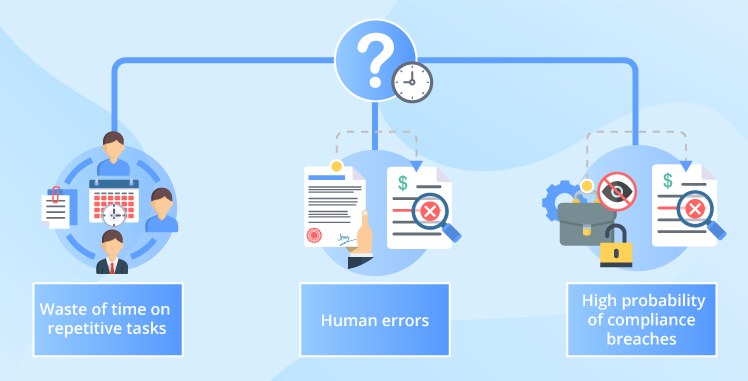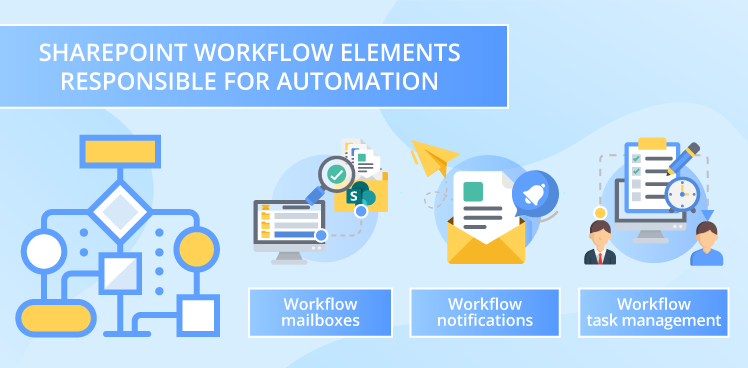SharePoint Business Process Automation: Options, Benefits and Limitations
Business process automation is highly appreciated by enterprises that deal with multiple interrelated processes like document and asset management. With business process automation tools, companies can decrease operational costs and increase employee productivity.
In this article, we’ll analyze the viability of SharePoint for business process automation based on our experience in SharePoint consulting and development. Having implemented multiple projects to streamline business processes, we are well aware of the benefits and limitations of SharePoint as a business process automation platform and want to share our knowledge with you. Our notable projects include implementation of a document approval workflow, a data connectivity solution, a records management system, an HR management system, a learning portal, and an employee portal.

When it’s time to turn to automation
Companies turn to business automation when they face such challenges as:
- Too much time is spent on repetitive tasks and simple workflows like contract lifecycle management. Thus, a contract’s approval by a sales department, an accounting department, a legal department and signing it by CEO may take 1-2 weeks.
- Human error that can lead to disrupted business processes or downtime. For example, critical errors may occur when data from a contract is manually transferred to an invoice.
- High probability of compliance breaches due to the lack of visibility into business processes and untimely scanning and installing relevant security updates.

Benefits
SharePoint is one of the first platforms that come into mind of companies who are seeking to automate their business processes. Even more so for enterprises that are already subscribed to Office 365. The reason behind SharePoint popularity lies in its key benefits:
Cost-effectiveness
License costs starting at $5.00 make SharePoint an affordable platform even for a small business. Besides, if companies don’t want complex workflows for inventory tracking or compliance support, SharePoint out-of-the-box workflows can easily satisfy their needs. For companies that already have SharePoint, cost-effectiveness of building business process automation using this platform is even more obvious.
Familiarity
User adoption issues are minimized as employees are already acquainted with the platform, for example, as a corporate intranet. This can also reduce the time on training employees to use automated workflows, so they can start getting value from a solution earlier.
Integration-friendliness
SharePoint integrates with Office 365 tools (Word, PowerPoint, OneNote) out of the box. This allows creating documents right in SharePoint, which facilitates initiating document-related workflows. Also, SharePoint integrates with enterprise systems (CRM, ERP, project management systems, etc.), which facilitates creating cross-company workflows and enhances visibility into a company’s digital environment.
Customizability
Due to extensive customization capabilities, SharePoint can be used to automate both processes common for all industries (onboarding, document feedback and approval, reporting, training, asset management, accounting, purchasing approvals, vacation approvals, help desk requests) as well as industry-specific processes in, for example:
- Healthcare (patient information management, patient billing, records management, compliance reporting, medical inventory and transportation management, incident management, insurance authorization approvals).
- Manufacturing (warehouse and procurement processes, quality control, product transportation and delivery, repair requests, site inspection).
- Banking (loan processing, automating credit and money transfers, integration with other automated bank systems (ABS), budget management).
- Law (case management, retainer agreement management, scheduling calls and meetings).
How to automate business processes with SharePoint
SharePoint helps to automate business processes through workflows. Specifically, the following SharePoint workflow elements are responsible for automation:
- Workflow mailboxes. This component ensures that workflow-related emails are stored in a separate place and are easily searchable and accessible to workflow participants with relevant permissions.
- Workflow notifications. Notifications enable workflow participants to be aware of all changes in a workflow. Thus, they won’t miss a new task or an important update without having to check a SharePoint site regularly.
- Workflow task management. SharePoint task management functionality allows managers to assign tasks for employees, set start and end dates and monitor task accomplishment. Thus, the tasks become fully visible with their implementation steps, time and assignees displayed. Also, employees can see their tasks well-structured, which enables them to easily plan their activities and prioritize tasks when needed.

Depending on the complexity of workflows a company needs to automate (linear or non-linear, three-step or multistep, with or without escalation, etc.), there are two ways to automate business processes with workflows:
1. By configuring built-in workflows
SharePoint has 5 workflows available out of the box that can be used to automate simple business processes:
- The approval workflow allows setting up an approval process for documents (contracts, invoices, policies, etc.), lists and libraries in an organization. It can be set up by adding a document to a list, library or content type. Settings enable specifying workflow participants, a number of approval steps and other parameters. For example, a purchase contract can be approved by a procurement specialist, CFO, and CEO.
An employee approves changes made to a contract.
- The feedback workflow is useful for team collaboration projects as it routes documents, lists and libraries to a predetermined group of users who can add their comments or questions to them. All the feedbacks are stored not in a document itself but in a special list for easy access and search.
- The signature workflow enables collecting digital signatures to a Word document or an Excel worksheet. For example, it allows adding a signature to an invoice after the document is finalized.
A person puts e-signature to a contract.
- The publishing workflow automatically guides documents, lists and libraries to authorized persons for review and approval. Then the workflow allows posting approved content to a site for all users to see it.
- The three-state workflow helps to monitor the status of a document, a list, or a library through three states, or phases. For example, when a trouble ticket is assigned to an IT team, it goes through the following states: Created, Work in Progress and Completed. The three-state workflow automatically notifies its owner about a document’s advancing through each state, which is helpful in business processes that require issue tracking like customer service.
2. By creating custom workflows
Custom workflows are used to automate more complex and specific business processes. Examples of custom workflows that can be created in SharePoint include:
- A weather forecast workflow. The workflow allows automated generating of weather reports on a daily basis. It is relevant for, for example, construction workers whose safety depends on weather conditions.
- A sales tax calculation workflow. This workflow enables automated calculating a sales tax depending on a product’s base price and a sales tax rate for a location where a product will be sold.
- An inventory tracking workflow. This workflow helps to track status, location, users, maintenance needs of a company’s vehicles, furniture, office equipment, etc.
Creating custom workflows in SharePoint requires applying specific tools that differ in functionality and IT skills needed to work with them. Thus, if you need to automate simple linear processes, you will need IT specialists who know how to work with SharePoint Designer and Microsoft Flow. These tools don’t require deep technical knowledge, so your in-house IT team can master them after proper training. For automating complex non-linear processes, you’ll need specialists with strong programming skills who can build workflows in Visual Studio.
Limitations
Although SharePoint has valuable benefits for business process automation, the platform has some serious drawbacks for the task, for example:
- The limited scope of built-in workflows. Although SharePoint out-of-the-box workflows can cover the main business needs of companies, they are not enough to automate complex business operations. So, custom workflows need to be created.
- Time and costs of custom workflow development. Due to the complexity of the implementation and maintenance of deeply customized workflows, workflow creation can be effort- and time-consuming. Moreover, advanced customization requires profound IT skills, so creating custom workflows may turn out to be expensive.
Afterword
SharePoint is suitable for business process automation, especially for companies that are already subscribed to SharePoint or Office 365. With SharePoint, you can create automated workflows, track their stages with the help of alerts and notifications and benefit from the task management functionality. However, to fully adjust the platform to your business needs, you’ll require custom workflows in most cases, and you’ll need to be ready to invest money and time in building them. To reduce costs and increase ROI of SharePoint automation, you need to make sure your vendor is good at prioritizing and optimizing business processes that need automation.

